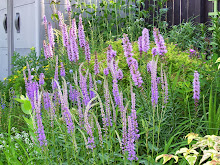Flowers, bees...honey!
I don't keep bees. I maintain a bee-friendly environment. Even before birds, bees are the largest group of visitors in my garden. (You mammals, I am talking to you mice and deer; war has been declared!) I provide water with easy perching places. I don't use herbicides in a pre-emptive manner and never as foliar sprays. I used a pesticide just once, on a cool day (It may have been less than 50 degrees that day. I hope all you bees stayed home that day, keeping your queen warm.). The apple blossoms had dropped. I was after the coddling moths who seem smitten by my Honeycrisp apple tree. (I did the climbing roses the same say to ward off the evil sawflies.)
Bees are kept in my neighborhood, a very short flight path from my raspberries, Seckl pear, strawberries, and apple. Yesterday, the beekeeper blessed me with a half pint of fresh honey, saying it had been a very good year.
Can honey have good years like wine? I'd like to know. Is there a "terroir" effect for honey? Maybe I am tasting the freshness of the honey before it has sat and evaporated to make it the overly, sickingly sweet sticky, fabricated mess you can sometimes accidentally buy in a retail setting. None the less, this honey was just the right amount of sweet, the right consistency on a spoon, without out any sediment or crystalization.
And, I swear I could taste just a hint of fruit and berries, and maybe...wild roses. It does not get any more local than this.
Sunday, August 30, 2015
Thursday, August 20, 2015
Large and Lush
 |
| Comfrey, symphytum officinale |
Large and lush, my symphytum officinale is taking up some real estate these days. A member of the borage family, symphytum or comfrey is a broad-leaved herb with hairy leaves and blue flowers. Typically it blooms May through early July, but mine has really spread out and appears to be setting up a second flush of bloom this year.
Sunday, August 16, 2015
Water Features
 |
| At Longwood Gardens |
This summer I saw a lot of water features in gardens. This is a round-up of those pictures.
 |
| From the famous Teacup Garden at Chanticleer |
 |
| Ubiquitous frog fountain at Winterthur's Enchanted Garden |
 |
| Motion-activated misting fairy ring of stone mushrooms at the Enchanted Garden at Winterthur. My son obviously became enchanted. |
 |
| Horse/cattle trough, are we in the Midwest? Nope. Winterthur again... |
 |
| Also at Winterthur |
 |
| Ceramic something something at Chanticleer held bubbling water. |
 |
| At Chanticleer, almost an afterthought, placed within the Teacup Garden |
 |
| A fun fountain at Longwood Gardens; the main "over the top DuPont style fountain which covers ACRES is undergoing renovations. |
 |
| Overflowing lotus form in the foyer area of the Longwood Conservatory |
 |
| Fun little fountain off to the side of the main waterfall in the Conservatory at Longwood. |
 |
| Waterfall in the Conservatory at Longwood. |
Saturday, August 15, 2015
August Bloom Day
 |
| Daylily 'Wind Dancer' |
 |
| Daylily 'Joan Senior' |
 |
| Sedum 'Autumn Joy' |
 |
| Hosta lancifolia |
 |
| Hydrangeas Anabelle and 'Quickfire' |
 |
| Rose 'John Cabot' |
Thursday, August 13, 2015
Into the Dirt (Part 1)
 |
| Bare ground, a rarity in garden |
I have often heard the maxim, "Learn what grows good for you and grow a lot of it." When a gardener first begins this is not bad advice. At a certain point, though, you are no longer a beginning gardener, but something more. It is this something more that drives me at this point in my gardening journey.
I will confess I am a plant collector. The very nature of this statement makes garden design difficult. Finding "the repeat" with different plants or a unifying line to draw the eye can be a challenge.
Tuesday, August 11, 2015
Chanticleer Garden
 |
| Pillars with the chicken from which the play on the French word chanticlere Chanticleer is named. |
Trees...of the Mid-Atlantic States
 |
| Franklinia, possibly extinct in the wild, a native American tree in bloom at Longwood Gardens |
We often walk right pass them. Here in central Wisconsin decent trees are a rarity and can be grouped into genus fairly quickly due to the small number represented.
 |
| One of |
 |
| Swamp magnolia at Winterthur |
 |
| Tall and straight, we have so few similar trees here. |
 |
| Tricolor beech espaliered on a stucco wall at Chanticleer |
 |
| One of the largest dogwood, cornus florida, I have ever seen. |
 |
| The oldest sycamore at Hagley Mills, the lower trunk does not even appear sycamore-like, similar to how old white pine change their bark as they age. |
Subscribe to:
Posts (Atom)












